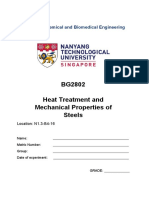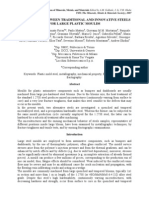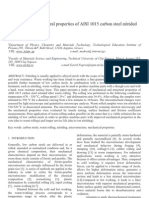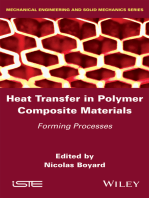Composite Materials
Composite Materials
Uploaded by
SinhrooCopyright:
Available Formats
Composite Materials
Composite Materials
Uploaded by
SinhrooOriginal Title
Copyright
Available Formats
Share this document
Did you find this document useful?
Is this content inappropriate?
Copyright:
Available Formats
Composite Materials
Composite Materials
Uploaded by
SinhrooCopyright:
Available Formats
Metal Science and Heat Treatment
Vol. 52, Nos. 9 10, 2010
COMPOSITE MATERIALS
UDC 621.785.3:669.017.3:669-419.4
EFFECT OF ANNEALING ON MARTENSITIC TRANSFORMATIONS
IN STEEL TiNi ALLOY EXPLOSION WELDED BIMETALLIC COMPOSITE
S. P. Belyaev,1 V. V. Rubanik,2, 3 N. N. Resnina,1 V. V. Rubanik (Jr.),2, 3 and O. E. Rubanik3
Translated from Metallovedenie i Termicheskaya Obrabotka Metallov, No. 9, pp. 30 34, September, 2010.
The effect of explosion welding on the kinetics of martensitic transformations in a steel TiNi alloy bimetallic composite and the effect of the temperature and duration of annealing on recovery of the characteristics
of the martensitic transformations are studied. It is shown that annealing in the range of 450 600C accompanied by retrogression of structure causes full recovery of the transformation kinetics in the alloy.
Key words: bimetallic composite, explosion welding, martensitic transformations, annealing.
drive operates in the following manner. The SMA member is
deformed in a low-temperature condition and connected to
the elastic member. In heating, the SMA member regains its
initial shape, deforms the elastic member, and this gives rise
to stresses in the system. In cooling in the range of the temperatures of forward martensitic transformation these stresses
initiate the effect of transformation plasticity in the SMA
member. As a result, it deforms and accumulates inelastic
strain, and the stress in the system is relaxed. In the subsequent heat cycles all the actions described are repeated thus
ensuring multiple action of the thermomechanical drive. In
most operating drives the elastic member and the SMA member are different bodies connected to each other. At the same
time, another possible solution is when two members, one of
which possess shape memory and the other possesses elastic
properties, constitute one body. This can be implemented in a
bimetallic composite. The advantage of this engineering solution is the possibility of attainment of maximum compactness and even miniaturization of the drive [3].
The shape memory alloy is commonly attached to other
metals by methods of laser or plasma welding [4, 5]. However, these processes have some disadvantages, the main of
which is the formation of a heat-affected zone due to local
heating of the material in the welded region. In this zone the
phase composition of the alloys [5], the grain size, and the
texture [4] differ considerably from the corresponding characteristics in the main volume of the joined members. This
causes substantial lowering of the strength of the bimetallic
composite [5] and worsens the operating properties [6]. It is
INTRODUCTION
Thermomechanical drives are articles produced from
shape memory alloys (SMA). The operating principle of the
drives is based on the capacity of the alloys to restore considerable inelastic deformations in heating and to develop considerable forces simultaneously. A spring fabricated from
SMA deformed preliminarily in a low-temperature martensitic state is a simple example of a thermomechanical drive.
Upon heating in the temperature range of the inverse martensitic transformation the spring recovers its initial shape and is
capable to perform work and overcome the counteracting
force [1]. Such a thermomechanical drive is a single-action
device, because in order to initiate its operation again the
spring should be deformed in a martensitic state again. Operation of a reusable thermomechanical drive can be based
either on the effect of reversible shape memory or on the use
of an elastic balance body. In the first case the thermochemical drive will be characterized by low displacements and
forces due to the special features of the reversible shape
memory effect [2]. The use of an elastic member in combination with an SMA member provides multiple operation of the
drive under repeated heat cycles without the need for repeated active deformation after each heating cycle. Such a
1
2
3
St. Petersburg State University, St. Petersburg, Russia (e-mail:
spb@smel.math.spbu.ru).
Vitebsk State Technological Institute, Vitebsk, Belarus.
Institute for Technical Acoustics of the National Academy of Sciences of Belarus, Vitebsk, Belarus.
432
0026-0673/10/0910-0432 2010 Springer Science + Business Media, Inc.
Effect of Annealing on Martensitic Transformations in Steel TiNi Alloy Composite
R B19
B2 R
Exo
natural to expect the best results from the use of cold explosion welding [7, 8]. In explosion welding the alloys experience high plastic deformations which change the temperature, succession, and fullness of implementation of the
martensitic transformations and hence the characteristics of
the shape memory effect. The consequences of plastic straining can be removed by regenerative tempering or annealing.
However, there are virtually no data on the effect of the temperature and duration of annealing on the recovery of properties of shape memory alloys in a bimetallic composite. The
aim of the present work consisted in studying the effect explosion and subsequent annealing on the kinetics of martensitic transformations in a shape-memory TiNi alloy in a bimetallic composite.
433
B19 B2
50
R B19
50
t, C
b
B2 R
In order to obtain a bimetal we chose plates of steel
Kh18N10T 50 50 1 mm in size and of alloy Ti 50.6 at.%
Ni 50 50 1.68 mm in size. A bimetallic composite was
formed by explosion welding at room temperature as described in [8]. The thickness of a bimetallic specimen was
2.3 mm. The bimetallic specimens and TiNi plates were subjected to isochronous annealing. The isochronous annealing
was performed at a temperature of 150 600C at a step of
50C with a hold for 20 min at each temperature. The development of the martensitic transformations was studied using
a Mettler Toledo 822e differential scanning calorimeter and
varying the temperature at a rate of 10 K/min.
RESULTS
Figure 1 presents the calorimetric curves obtained due to
cooling and heating a TiNi plate in the state as delivered and
a bimetallic specimen. In the case of cooling of the TiNi
plate the calorimetric curve has two peaks of heat emission
in the ranges of 7 4C and 26 47C; in the case of
heating we observe one peak of heat absorption in the range
of 3 18C. Comparison of the calorimetric data with the
results of measurement of electrical conductivity allowed us
to establish that the first peak of heat emission is as result of
transformation of a cubic B2-phase into a rhombohedral
R-phase; the second peak is caused by transformation of the
rhombohedral R-phase into a monoclinic B19-phase. In
heating, we detected a reverse transformation of the monoclinic B19-phase directly into a cubic B2-phase.
After explosion welding martensitic transformations in
the TiNi alloy develop in the same succession. In cooling we
observe the B2 R B19 chain of transformations and in
heating we observe a B19 B2 transformation (Fig. 1b ).
However, the temperatures of the structural transformations
increase substantially, the temperature ranges of the transformations widen, and the energy of the transformations decreases. For example, the temperature Ri of the start of the
Exo
METHODS OF STUDY
B19 B2
50
50
t, C
Fig. 1. Calorimetric curves obtained in cooling and heating of a
plate of TiNi alloy (a) and of bimetallic composite (b ).
B2 R transformation is 7C in the initial TiNi plate, while
in the bimetallic composite it increases to 60C; the energy
of the transition decreases from 4.2 to 0.7 J/g. The temperature Mi of the start of the R B19 transformation increases
from 26 to 47C. The temperature Ai of the start of the
backward transformation increases from 18 to 65C. Growth
in the temperature of phase transformations, widening of
their temperature ranges, and decrease in the energy are typical for alloys subjected to high plastic deformations. The decrease in the transformation energy is obviously caused by
the decrease in the volume of the material undergoing the
structural transformation. This agrees well with the data of
[9], in which it is shown that plastic deformation causes suppression of martensitic transformations.
The consequences of the action of plastic strain can be
removed to a considerable degree by annealing of the bimetallic composite. In order to determine the temperature range
of recovery of its properties a bimetallic specimen was subjected to isochronous annealing. The results obtained (Fig. 2)
show that growth in the annealing temperature to 400C does
not virtually change the location of the calorimetric peaks
observed in cooling and heating. Only their intensity increases somewhat. Annealing at 450 550C shifts the thermal peaks to lower temperatures and their intensity increases
substantially. Growth in the temperature to 600C shifts the
second peak on the cooling curve to higher temperatures,
which causes overlapping of the peaks of heat emission
434
S. P. Belyaev et al.
t,
600
Ri
Emission of heat
50
Mi
550
Rf
500
400
300
Mf
Without h.t.
50
50
50
t, C
200
400
600
tan ,
E, J/g
600
Emission of heat
550
10
500
400
300
Without h.t.
b
0
50
t, C
100
Fig. 2. Calorimetric curves obtained in cooling (a) and heating (b )
of a bimetallic plate subjected to isochronous annealing at various
temperatures (given at the curves in C).
caused by the B2 R and R B19 transformations. In the
heating process heat is absorbed in many stages.
Figure 3a presents the dependences of the temperatures
of the start and end of the B2 R (Ri and Rf ) and R B19
(Mi and Mf ) transformations on the annealing temperature. It
can be seen that the kinetics of the martensitic transformations changes starting with annealing temperature of 300C.
At tan > 300C the temperature range of the B2 R transformation becomes narrower. Growth in the annealing temperature from 300 to 400C decreases this range from 45 to 16C.
At tan 400C the transformation temperature decreases
markedly. The B2 R transition is finished fully before the
beginning of the R B19 transformation and therefore the
calorimetric dependences have two well manifested peaks
(see Fig. 2). However, after annealing at 600C the temperatures of the two transformations coincide again.
Growth in the annealing temperature is also accompanied by a change in the transformation energy determined as
the area under the calorimetric peaks. Figure 3b presents the
dependence of the total energy of the B2 R and R B19
transformations on the annealing temperature. It can be seen
that the transformation energy increases upon growth in the
annealing temperature. It seems that this indicates the in-
200
400
600
tan ,
Fig. 3. Dependence of the transformation temperatures (a) and of
the emitted energy (b ) on the temperature of isochronous annealing
of a bimetallic plate (Ri and Rf are the initial and final temperatures
of the B2 R transition; Mi and Mf are the initial and final temperatures of the R B19 transformation).
volvement of larger and larger volumes of the material into
the phase transition.
The changes in the kinetics of martensitic transformations in annealing may be connected not only with the retrogression processes developing in plastically deformed alloy.
Heat treatment of TiNi alloys with excess nickel content and
relatively equiatomic composition is known to cause segregation of secondary phases, which also stimulates changes in
the temperatures and in the succession of the transformations
[1, 10]. It is obvious that similar processes develop in the
studied alloy too. This is proved by the experiments with an
initial undeformed specimen of the alloy fabricated from a
plate not subjected to explosion. The respective calorimetric
curves are presented in Fig. 4. In contrast to the data obtained
after annealing of the bimetallic specimen, the temperature
of the B2 R transformation changes in the initial NiTi
plate after annealing at even 300C. In addition, the course of
the backward transformation, in which the crystal lattice is
restructured from a B19- phase into a B2-phase, changes and
develops through an intermediate R-phase; the calorimetric
curve has two well manifested peaks of heat absorption
(Fig. 4b ). Growth in the annealing temperature to 400C
promotes further increase in the temperature of this transfor-
Effect of Annealing on Martensitic Transformations in Steel TiNi Alloy Composite
435
Mi Mf ,
Emission of heat
600
550
500
400
300
50
Without h.t.
50 t, C
600
550
Emission of heat
500
400
300
Without h.t.
50
50
t, C
Fig. 4. Calorimetric curves obtained in cooling (a) and heating (b )
of a plate of TiNi alloy subjected to isochronous annealing at various
temperatures (given at the curves in C).
mation. This is accompanied by some growth in the temperatures of the R B19 transformation too. Annealing at
500C does not affect the course of the forward transformations and only lowers somewhat the temperatures of the
B2 R transformation. The backward transformation again
develops in one stage, like in the not annealed material. Further increase in the annealing temperature results in a single-stage forward transition from a B2 structure right to a
monoclinic B19.
The results obtained show that isochronous annealing of
the initial plate not subjected to explosion affects the kinetics
of martensitic transformations in a different manner. The
temperatures of the B2 R transformation are more sensitive to annealing at 300 400C, which has not been detected for the bimetallic plate, and the formation of rhombohedral phase is suppressed fully after heating to tan > 500C.
Such changes in the characteristics of martensitic transformations developing in the TiNi plate agree well with the
available data on changes in the structure of the alloy upon
annealing [1, 10]. For example, annealing at 300 450C
promotes formation of particles of a Ti3Ni4 phase, which create rhombohedral distortions in the TiNi matrix, and this initiates the occurrence of both forward and backward transformations through an intermediate R-phase [11]. In addition,
the temperatures of the transformations increase because of
60
40
20
0
200
400 tan ,
Fig. 5. Change in the temperature interval of R B19 transformation as a function of temperature and duration of annealing of bimetal plate and TiNi alloy: &) bimetal, tan = 20 min; =) bimetal,
tan = 120 min; )) TiNi alloy, tan = 20 min.
the depletion of the matrix of nickel due to formation of
Ti3Ni4 [12]. At 450 500C the particles start to dissolve,
which is accompanied by growth in the concentration of
nickel in the TiNi matrix and hence by an increase in the
temperatures of the transformations. In the case of annealing
at 550C the particles dissolve and the matrix undergoes only
one B2 B19 transformation during cooling, which occurs
at low temperatures.
DISCUSSION
We see that the laws of variation of the kinetics of martensitic transformations during annealing of a bimetallic
specimen and a specimen of TiNi alloy not subjected to explosion differ substantially. It is obvious that the processes of
segregation of secondary phases in explosion-deformed
specimens are either suppressed to a considerable degree or
do not affect substantially the changes in the annealing process. The main role in the recovery of properties of the deformed alloy belongs to retrogression and recrystallization,
which are accompanied by rearrangement of the defects of
the structure and lowering of the density of lattice imperfections. This is the reason behind the decrease of the ranges of
martensitic transitions and growth in the energy of the transformation (see Fig. 3). The recovery of properties is the most
intense when the annealing is performed at 450 600C. Experiments show that long-term annealing at such temperatures leads to full restoration of the kinetics of martensitic
transformations. Figure 5 shows the variation of the temperature range of the R B19 transformation upon growth in
the time of annealing at various temperatures. It can be seen,
that the range Mi Mf in the bimetallic specimen is 46C after 20-min hold at 450C and shortens to 17C after a
120-min hold, just as in the undeformed alloy.
CONCLUSIONS
We may infer that high plastic strain arising in a bimetallic steel TiNi alloy composite changes the kinetics of
436
martensitic transformations in titanium nickelide. The characteristic temperatures and the temperature ranges of the
transformations grow, and the energy emitted and absorbed
in the transformations decreases considerably. Subsequent
annealing in a temperature range of 450 600C accompanied by retrogression of structure causes full restoration of
the kinetics of the transformations in the alloy.
The work has been performed within a Russia Belarus grant (RFFI No. 08-08-900010 Bel a and BFFI
No. T08R-225) and a grant of the President of the Russian
Federation for supporting young candidates of science
No. MK-466.2010.8.
REFERENCES
1. I. Ohkata, Y. Suzuki, and K. Otsuka, in: C. M. Wayman (ed.),
Shape Memory Materials, Cambridge University Press, Cambridge (1998).
2. V. A. Likhachev, S. L. Kuzmin, and Z. P. Kamentseva, The Effect of Shape Memory [in Russian], LGU, Leningrad (1987),
216 p.
3. A. V. Shchelyakov, A. G. Kirilin, V. V. Koledov et al, Reversible bending deformation of a composite material based on a
shape memory alloy, in: Mater. All-Union Sci.-Eng. Students
Conf. Student Spring 2008: Machine Building Technologies,
MGTU Im. N. E. Baumana, Moscow (2008), pp. 128 130.
S. P. Belyaev et al.
4. H. Gugel, A. Schuermann, and W. Theisen, Mater. Sci. Eng.,
481 482A, 668 671 (2008).
5. C. Eijk, H. Fostervoll, Z. K. Sallom, and O. Akselsen, in: ASM
Materials Solutions 2003 Conference, Pittsburgh, Pennsylvania, USA, 13 15 October (2003) (http://www.sintef.no/upload/Materialer kjemi/Metallurgi/Prosess/ paperASM2003.pdf).
6. A. Favlo, F. M. Furgiuele, and C. Matetta, Mater. Sci. Eng.,
412A, 235 240 (2005).
7. R. Prummer and D. Stockel, in: K. P. Staudhammer, L. E. Murr,
and M. A. Meyers (eds.), Fundamental Issues and Applications
of Shock-Wave and High-Strain-Rate Phenomena, Elsevier,
Hardbound (2001).
8. O. E. Rubanik, V. V. Klubovich, and V. V. Rubanik (Jr.), Explosion welding and properties of TiNi-steel composites, in: 8th
Int. Conf. Advanced Machine-Building Technologies, Kranevo, Belarus, 2008 [in Russian], pp. 185 189 (http://amo.dmtproduct.com/amo-08/pdfamo08/27.pdf).
9. D. Miller and D. C. Lagoudas, Smart Mater. Struct., 9(5),
640 652 (2000).
10. V. N. Khachin, V. G. Pushin, and V. V. Kondratev, Titanium
Nickelide: Structure and Properties [in Russian], Nauka, Moscow (1992), 160 p.
11. V. I. Zeldovich, I. V. Khomskaya, N. Yu. Frolova, and
G. A. Sbitneva, in: Proc. XXXVIII Int. Seminar Urgent Problems of Strength (St. Petersburg, Sept. 24 27, 2001) [in Russian], Izd. SpbGU, St. Petersburg (2001), pp. 63 67.
12. J. Khalil-Allafl, A. Dlouhy, and G. Eggeler, Acta Mater., 50,
4255 4274 (2002).
You might also like
- The 9-Figure: Sales ScriptDocument22 pagesThe 9-Figure: Sales ScriptAngé PazNo ratings yet
- MS Excel 2010Document24 pagesMS Excel 2010Shahzad HussainNo ratings yet
- Metals-09-00939 OKDocument14 pagesMetals-09-00939 OKRebeca Francis Moran CamposNo ratings yet
- BG2802 Heat Treatment and Mechanical Properties of SteelsDocument11 pagesBG2802 Heat Treatment and Mechanical Properties of SteelsVenus LimNo ratings yet
- Influence of The Temperature of The Preliminary Heating and Furlough Defect Metallic Product and Way To Their LiquidationsDocument6 pagesInfluence of The Temperature of The Preliminary Heating and Furlough Defect Metallic Product and Way To Their Liquidationsindex PubNo ratings yet
- Characterization of A Hot-Rolled CuAlNiTi Shape Memory AlloyDocument5 pagesCharacterization of A Hot-Rolled CuAlNiTi Shape Memory AlloySimoes JBNo ratings yet
- Effect of Tempering Pass On HSLA-80 Steel HAZ MicrostructuresDocument8 pagesEffect of Tempering Pass On HSLA-80 Steel HAZ MicrostructuresElias KapaNo ratings yet
- Hardening From The Liquid StateDocument5 pagesHardening From The Liquid StateSinhrooNo ratings yet
- High-Temperature Tensile Deformation and Thermal Cracking of Ferritic Spheroidal Graphite Cast IronDocument9 pagesHigh-Temperature Tensile Deformation and Thermal Cracking of Ferritic Spheroidal Graphite Cast IronRegiane SenaNo ratings yet
- Introduction of Heat and Surface Treatment PDFDocument45 pagesIntroduction of Heat and Surface Treatment PDFScott BakerNo ratings yet
- 05 Heat Treatments To Produce Ferrite and PerliteDocument23 pages05 Heat Treatments To Produce Ferrite and PerliteRicardo Fidel Duarte SánchezNo ratings yet
- MSF 941 334Document6 pagesMSF 941 334Steve OoiNo ratings yet
- 1 s2.0 S0921509310013742 Main PDFDocument6 pages1 s2.0 S0921509310013742 Main PDFEidelsayedNo ratings yet
- The Effect of Microstructure On Tensile Behaviour of X80 Microalloyed SteelDocument7 pagesThe Effect of Microstructure On Tensile Behaviour of X80 Microalloyed SteelMarcelo Varejão CasarinNo ratings yet
- Experience in SimulationDocument5 pagesExperience in SimulationGowrav ShenoyNo ratings yet
- Influence of Cold Forging and Annealing On Microstructure and Mechanical Properties of A High-Mn TWIP SteelDocument7 pagesInfluence of Cold Forging and Annealing On Microstructure and Mechanical Properties of A High-Mn TWIP SteelFabricio Ronaldo Zamata CorimanyaNo ratings yet
- Lichioiu IDocument6 pagesLichioiu ICristina MaierNo ratings yet
- Metals 13 01301Document11 pagesMetals 13 01301iqbal haiderNo ratings yet
- Artigo ZucatoDocument5 pagesArtigo ZucatocaroleuzinhaNo ratings yet
- 02 Effect of Chemical Composition and ProcessingDocument49 pages02 Effect of Chemical Composition and ProcessingAli MoussaNo ratings yet
- Effect of Heat Treatment On Microstructure and Hardness of Steel 67sicr5Document7 pagesEffect of Heat Treatment On Microstructure and Hardness of Steel 67sicr5ZarikhNo ratings yet
- Bake Hardening ST 14 SteelDocument8 pagesBake Hardening ST 14 SteelDavid JendraNo ratings yet
- Mechanical Properties Improvement of Low Carbon Steel by Combined Heat TreatmentsDocument15 pagesMechanical Properties Improvement of Low Carbon Steel by Combined Heat TreatmentsReyza PrasetyoNo ratings yet
- Thermo-Mechanical Treatment of The C-MN Steel With NB, Ti, V and B MicroadditionsDocument4 pagesThermo-Mechanical Treatment of The C-MN Steel With NB, Ti, V and B MicroadditionsGaurav TripathiNo ratings yet
- Ductile Iron Cooling GraphDocument5 pagesDuctile Iron Cooling GraphbvphimanshuNo ratings yet
- Comparison Between Traditional and Innovative SteelsDocument10 pagesComparison Between Traditional and Innovative SteelsIonut AdrianNo ratings yet
- AISI 1015 Carbon Steel NitridedDocument4 pagesAISI 1015 Carbon Steel NitridedRamil SerdanNo ratings yet
- Heat Treatment of 1045 Steel PDFDocument17 pagesHeat Treatment of 1045 Steel PDFH_DEBIANENo ratings yet
- Study of The Mechanical and Thermal Properties of Sn-5Sb (DR Alla Bahgat)Document15 pagesStudy of The Mechanical and Thermal Properties of Sn-5Sb (DR Alla Bahgat)eidelsayedNo ratings yet
- Bonitus Impactos PDFDocument7 pagesBonitus Impactos PDFEdna Odette Melo UscangaNo ratings yet
- Introduction To Ductile IronDocument8 pagesIntroduction To Ductile IronNatalino FonsecaNo ratings yet
- Materials Science & Engineering A: G.M.A.M.El Fallah, H.K.D.H. Bhadeshia TDocument9 pagesMaterials Science & Engineering A: G.M.A.M.El Fallah, H.K.D.H. Bhadeshia Tsayyed bassir ajellehNo ratings yet
- PhysicsDocument5 pagesPhysicsAditya Budi FauziNo ratings yet
- Physical Simulation For Hot Rolling Policy of Electrical Si-SteelsDocument10 pagesPhysical Simulation For Hot Rolling Policy of Electrical Si-SteelsTJPRC PublicationsNo ratings yet
- Effect of Cooling Rate DIDocument6 pagesEffect of Cooling Rate DIKarthiKeyan SNo ratings yet
- Capdevila 2006 - Influence of Processing Parameters On The RX Microstructure of Extra-LC SteelsDocument10 pagesCapdevila 2006 - Influence of Processing Parameters On The RX Microstructure of Extra-LC SteelsElliot AmadiNo ratings yet
- IWIT2017-Proceeding FullpaperDocument8 pagesIWIT2017-Proceeding FullpaperKittichai SojiphanNo ratings yet
- Stretch - Angeability of A High-Strength TRIP Type Bainitic SheetDocument7 pagesStretch - Angeability of A High-Strength TRIP Type Bainitic SheetKhomasan JumpasriNo ratings yet
- Characterization of The Microstructure Evolution in A Nickel Base Superalloy During Continuous Cooling ConditionsDocument12 pagesCharacterization of The Microstructure Evolution in A Nickel Base Superalloy During Continuous Cooling Conditionseluucee81No ratings yet
- ICMH2012Document9 pagesICMH2012Ricardo BelibioNo ratings yet
- Dilatometric and Hardness Analysis of C45 Steel Tempering With Different Heating-Up RatesDocument4 pagesDilatometric and Hardness Analysis of C45 Steel Tempering With Different Heating-Up RatesInaamNo ratings yet
- Dilatometric and Hardness Analysis of C45 Steel PDFDocument4 pagesDilatometric and Hardness Analysis of C45 Steel PDFInaamNo ratings yet
- Influence of Warm-Working On Quality of AISI 1015 Carbon SteelDocument7 pagesInfluence of Warm-Working On Quality of AISI 1015 Carbon SteelRicho Firdaus TumanggorNo ratings yet
- Dilatometric and Hardness Analysis of C45 Steel Tempering With Different Heating-Up RatesDocument4 pagesDilatometric and Hardness Analysis of C45 Steel Tempering With Different Heating-Up RatesInaamNo ratings yet
- Volchok 22Document4 pagesVolchok 22amitkkambleNo ratings yet
- 15 Ni Cu Mo NB 5Document14 pages15 Ni Cu Mo NB 5bejaouiabdelhamidNo ratings yet
- Behaviour of Structural Carbon Steel at High Temperatures PDFDocument10 pagesBehaviour of Structural Carbon Steel at High Temperatures PDFAlex GigenaNo ratings yet
- Effect of Coiling Temperature On Oxide Scale of Hot-Rolled StripDocument8 pagesEffect of Coiling Temperature On Oxide Scale of Hot-Rolled StripAnish ChaudharyNo ratings yet
- The Kinetics of Phase Transformations During Tempering of Cr-Mo-V Medium Carbon SteelDocument4 pagesThe Kinetics of Phase Transformations During Tempering of Cr-Mo-V Medium Carbon SteelfdcarazoNo ratings yet
- Effects of Microalloying Elements On Mechanical Properties of Reinforcing BarsDocument6 pagesEffects of Microalloying Elements On Mechanical Properties of Reinforcing BarsHany KhalifaNo ratings yet
- Microstructural Behaviour of Tempering Steels During Precision Forging and Quenching From Hot-Forming TemperaturesDocument8 pagesMicrostructural Behaviour of Tempering Steels During Precision Forging and Quenching From Hot-Forming TemperaturesAnuj ShahNo ratings yet
- Study of The Effect of Solidification On Graphite Flakes Microstructure and Mechanical Properties of An ASTM A-48 Gray Cast Iron Using Steel MoldsDocument6 pagesStudy of The Effect of Solidification On Graphite Flakes Microstructure and Mechanical Properties of An ASTM A-48 Gray Cast Iron Using Steel MoldsagustingrtNo ratings yet
- P91 Material PDFDocument7 pagesP91 Material PDFpanduranganraghuramaNo ratings yet
- Clarke2014 CarbidesDocument11 pagesClarke2014 CarbidesmadyeNo ratings yet
- 6.study FullDocument8 pages6.study FullTJPRC PublicationsNo ratings yet
- Temper Bead Welding 36036664Document9 pagesTemper Bead Welding 36036664sv1xv100% (1)
- Metals 09 00916Document8 pagesMetals 09 00916Abdul RafiNo ratings yet
- Heat Transfer in Polymer Composite Materials: Forming ProcessesFrom EverandHeat Transfer in Polymer Composite Materials: Forming ProcessesNicolas BoyardNo ratings yet
- Ceramics for Energy Conversion, Storage, and Distribution SystemsFrom EverandCeramics for Energy Conversion, Storage, and Distribution SystemsThomas PfeiferNo ratings yet
- Ultra-High Temperature Ceramics: Materials for Extreme Environment ApplicationsFrom EverandUltra-High Temperature Ceramics: Materials for Extreme Environment ApplicationsWilliam G. FahrenholtzNo ratings yet
- Heating IN AN Electrically Conducting Layer Carbon-Containing Particles OFDocument4 pagesHeating IN AN Electrically Conducting Layer Carbon-Containing Particles OFSinhrooNo ratings yet
- Effect of Various Kinds of Thermomechanical Treatment On The Structure and Properties of Steels Studied Using Acoustomicroscopic MethodsDocument5 pagesEffect of Various Kinds of Thermomechanical Treatment On The Structure and Properties of Steels Studied Using Acoustomicroscopic MethodsSinhrooNo ratings yet
- Foreign TechnologyDocument1 pageForeign TechnologySinhrooNo ratings yet
- Phase Composition of Scale of Hot-Rolled Automobile Sheet Steel 08yuDocument2 pagesPhase Composition of Scale of Hot-Rolled Automobile Sheet Steel 08yuSinhrooNo ratings yet
- Hydrostatic Extrusion at 100°C and Its Effect On The Grain Size and Mechanical Properties of Magnesium AlloysDocument5 pagesHydrostatic Extrusion at 100°C and Its Effect On The Grain Size and Mechanical Properties of Magnesium AlloysSinhrooNo ratings yet
- Hardness OF: CementiteDocument2 pagesHardness OF: CementiteSinhrooNo ratings yet
- 1006 1009Document4 pages1006 1009SinhrooNo ratings yet
- 382 385 PDFDocument4 pages382 385 PDFSinhrooNo ratings yet
- 374 376 PDFDocument3 pages374 376 PDFSinhrooNo ratings yet
- 386 389 PDFDocument4 pages386 389 PDFSinhrooNo ratings yet
- 390 394 PDFDocument5 pages390 394 PDFSinhrooNo ratings yet
- Effect of Alloying, Heat Treatment, and Deformation On The Structure and Properties of Damping Z N - A I AlloysDocument4 pagesEffect of Alloying, Heat Treatment, and Deformation On The Structure and Properties of Damping Z N - A I AlloysSinhrooNo ratings yet
- Protective Properties of A Nitrogen Atmosphere With An Admixture of Natural GasDocument4 pagesProtective Properties of A Nitrogen Atmosphere With An Admixture of Natural GasSinhrooNo ratings yet
- Hardening From The Liquid StateDocument5 pagesHardening From The Liquid StateSinhrooNo ratings yet
- Technology of Heat Treatment: Volume-Surface Hardening of by A High-Speed Water Stream Railroad Transport PartsDocument5 pagesTechnology of Heat Treatment: Volume-Surface Hardening of by A High-Speed Water Stream Railroad Transport PartsSinhrooNo ratings yet
- E 1 - 6 3 8 8 - L o - / Y) - 7 - Zi : Corporation, StreetDocument1 pageE 1 - 6 3 8 8 - L o - / Y) - 7 - Zi : Corporation, StreetSinhrooNo ratings yet
- 9 (I,, TillDocument4 pages9 (I,, TillSinhrooNo ratings yet
- 12 Biology Notes ch13 Organisms and Populations PDFDocument10 pages12 Biology Notes ch13 Organisms and Populations PDFYash GuptaNo ratings yet
- HyBase6100 Service Manual V1.0 enDocument92 pagesHyBase6100 Service Manual V1.0 enLeoni Anjos100% (1)
- Surveying DictionaryDocument6 pagesSurveying DictionaryMarijanaJNo ratings yet
- Ubd Lesson Plan On ConflictDocument2 pagesUbd Lesson Plan On Conflictapi-302592614No ratings yet
- The Disadvantages of An Elite EducationDocument8 pagesThe Disadvantages of An Elite EducationPau PastorNo ratings yet
- Phys Expt 1Document3 pagesPhys Expt 1JustineEduaveNo ratings yet
- Social and Political StratificationDocument11 pagesSocial and Political StratificationJezzel Jane RomerdeNo ratings yet
- Discussion Task 5Document5 pagesDiscussion Task 5Tasya tasyaNo ratings yet
- Curricular Annual Planification SecondDocument5 pagesCurricular Annual Planification Secondmary_roman10No ratings yet
- Complete Material of PPC v1 - 2Document308 pagesComplete Material of PPC v1 - 2Prashanth GanjiNo ratings yet
- Handwriting IdentificationDocument14 pagesHandwriting IdentificationfebejoydimasanaNo ratings yet
- QB HindiDocument119 pagesQB HindiAryan PradhanNo ratings yet
- Maria 1 PDFDocument612 pagesMaria 1 PDFMariaIoanaTelecan100% (1)
- Castalia - User ManualDocument108 pagesCastalia - User ManualprgjazzNo ratings yet
- Silingofer Arm FailureDocument51 pagesSilingofer Arm FailurekrunalNo ratings yet
- Platinum Metal Review in Dentistry, JewleryDocument78 pagesPlatinum Metal Review in Dentistry, JewleryRose SkyNo ratings yet
- HijackDocument3 pagesHijackLe Dinh Thinh100% (3)
- Java 5 TigerDocument17 pagesJava 5 TigersandeepveersNo ratings yet
- 017 - Chapter 3 - L13Document6 pages017 - Chapter 3 - L13nanduslns07No ratings yet
- Ijasft 5 140Document7 pagesIjasft 5 140peertechzNo ratings yet
- Muslim Muslim, Ade Dwi Sasanti, Apriana Apriana: Online Pada Http://joas - Co.idDocument11 pagesMuslim Muslim, Ade Dwi Sasanti, Apriana Apriana: Online Pada Http://joas - Co.idAnkaranaRenvaNo ratings yet
- Portfolio Day Monitoring 2nd ArchimedesDocument1 pagePortfolio Day Monitoring 2nd ArchimedesLOWIE ATCHASONo ratings yet
- 19-Article Text-23-1-10-20190326Document9 pages19-Article Text-23-1-10-20190326taabaNo ratings yet
- FM Approval Requirements For DI PipeDocument25 pagesFM Approval Requirements For DI Pipemmkamran1017No ratings yet
- Sophia Virus Brochure BTTDocument2 pagesSophia Virus Brochure BTTapi-254972421No ratings yet
- National Police Academy SynopsisDocument4 pagesNational Police Academy SynopsisAparna Raghuraman60% (5)
- Y207 Machine Safety Guide enDocument144 pagesY207 Machine Safety Guide engwamitiNo ratings yet
- Orthography and Phonemes in Pashto AfghanDocument10 pagesOrthography and Phonemes in Pashto AfghanCălin CâmpianuNo ratings yet









































































































